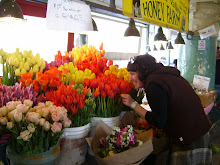The following article talks about a public art project in New York that I thought was very clever and just plain cool. I especially found the economic portion interesting. I think it's awesome that artistic expression in a landscape can boost our economy. Enjoy.
Artist’s Waterfalls Turn on NYC
Danish artist Olafur Eliasson designs and builds four cataracts that he hopes will provide spectators with a new view of the city’s skyline.
By Verena Dobnik, AP
Related Articles
Slide Show: Unique Architecture
Vacation Doc: What to See on East Coast Trip
Search: Olafur Eliasson's Art
See all Cultural Travel Articles
If they pay attention to it at all, many people view the water off Manhattan's East Side as a flat, even boring expanse stretching under a series of bridges.Not this summer.Now until Oct. 13, four mammoth waterfalls roar and plunge into the East River and New York Harbor in a multimillion-dollar engineering feat designed by Danish artist Olafur Eliasson."Here in New York, water is everywhere. We take the water for granted," Eliasson said. "I want to suggest — now, it's not about the land, now it's about what's between the land.""The New York City Waterfalls" is the city's largest public art project since 2005, when artists Christo and his wife, Jeanne-Claude, adorned 23 miles of Central Park's paths with thousands of saffron drapes. Eliasson, 41, creates indoor weather systems that incorporate elements like temperature, moisture, aroma and light. He's best known for his 2003 tour de force, "The Weather Project," which drew about 2 million people to London's Tate Modern to see a glowing sun "rise" in a gallery — an effect he created by using a mist machine, mirrors and hundreds of light bulbs.For this project, since there are no cliffs for water to pour over, metal scaffolds provide the framework for each waterfall. A system of pumps carries water up to a trough, where it will be released in a frothy cascade — about 35,000 gallons every minute for all four falls.The falls will be turned on every day from 7 a.m. to 10 p.m. and illuminated after sunset.They will roar off Governors Island in the harbor and into the East River at the Brooklyn base of the Brooklyn Bridge, Pier 35 near the Manhattan Bridge and off the Brooklyn Promenade. The highest will stand 120 feet tall, or almost the height of the Statue of Liberty, minus its pedestal.They will be visible from the Brooklyn and Manhattan waterfronts and from the pedestrian and bike lanes on the Brooklyn Bridge."My work is ... about the relationship between the waterfalls, the journey around this part of town and the spectator," Eliasson said. "I want people to see something which is personal. I want them to see themselves, essentially. I'm not offended when people say 'This is not art.'""Waterfalls" is expected to generate at least $55 million in economic activity for the city."The project promises to make a big splash in our local economy by attracting thousands of sightseers to town, who will then spend money in our restaurants, hotels and stores," Mayor Michael Bloomberg said.Hotels are advertising special packages and tourist agencies are offering bicycle and boat excursions.More than 5 million people saw "Gates," including about 1.5 million out-of-town visitors, pumping about $254 million into the economy.The $15.5 million cost of "Waterfalls" was raised by the Public Art Fund, a private not-for-profit organization. Individuals, foundations and corporations — including Bloomberg's own media company, Bloomberg LP — donated $13.5 million, and a state agency picked up the rest of the tab.It's not the first time Eliasson has experimented with water. In his 1993 "Beauty," he produced a rainbow in a Danish gallery by projecting light across a fine mist of water. And for a work called "Green River" in 2000, he poured nontoxic green dye into a river in Stockholm.Children were included in the plans for "Waterfalls." The Public Art Fund collaborated with the city's Department of Education to assemble study guides for teachers taking their classes to see the displays."Children tend to see things very different than grown-ups," Eliasson said, explaining that while adults might see a static landscape in a waterfall, a child may see it as vital and changing.Eliasson said the goal of his project was to take spectators, regardless of age, beyond the two-dimensional postcard image of the New York skyline."New York is sort of the icon of the modern city. ... It's a city everybody has a view on," he said. "There's something quite challenging about trying to, let's say, shake the image that people have of this city."On the Web:Waterfalls: http://www.nycwaterfalls.org/
Thursday, July 10, 2008
Subscribe to:
Post Comments (Atom)

No comments:
Post a Comment